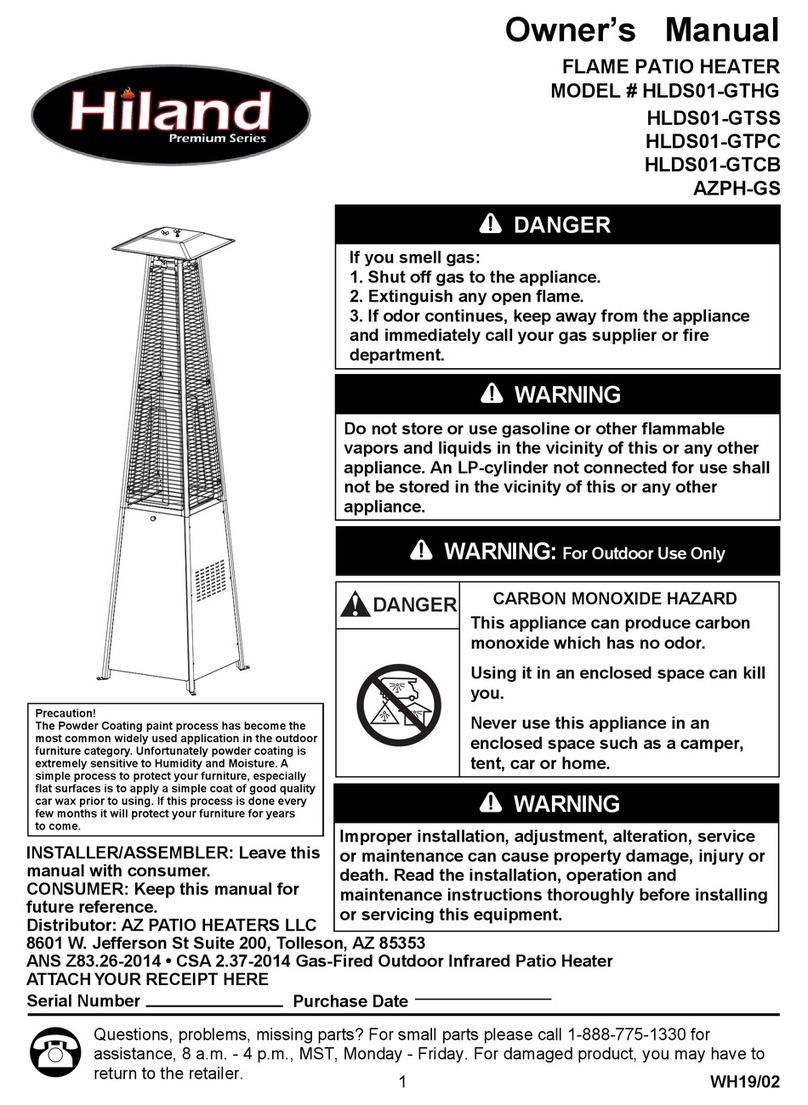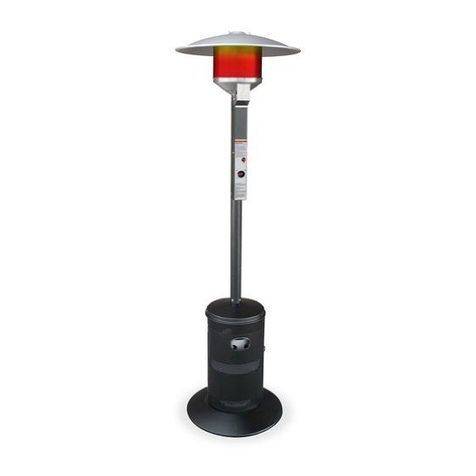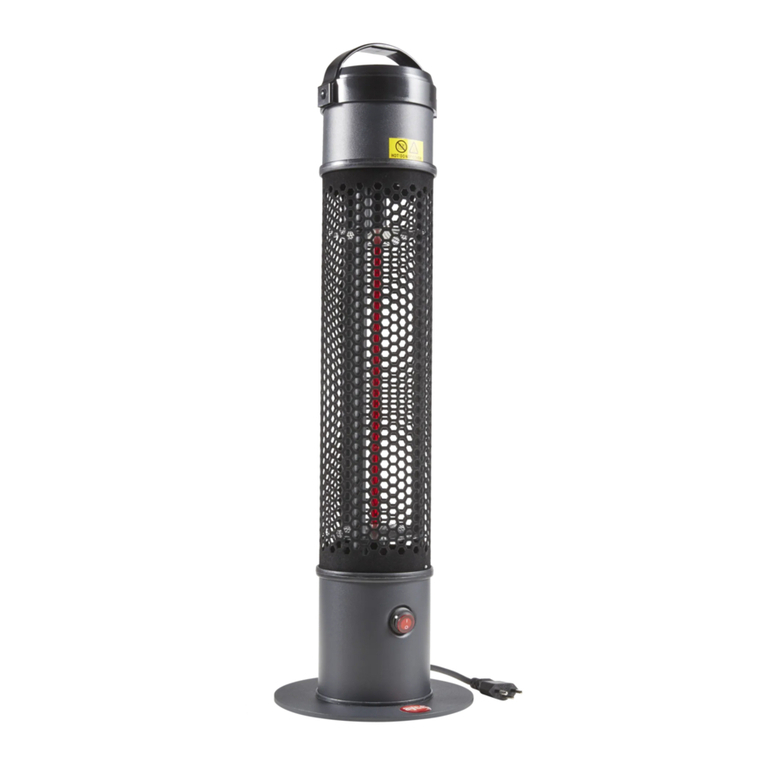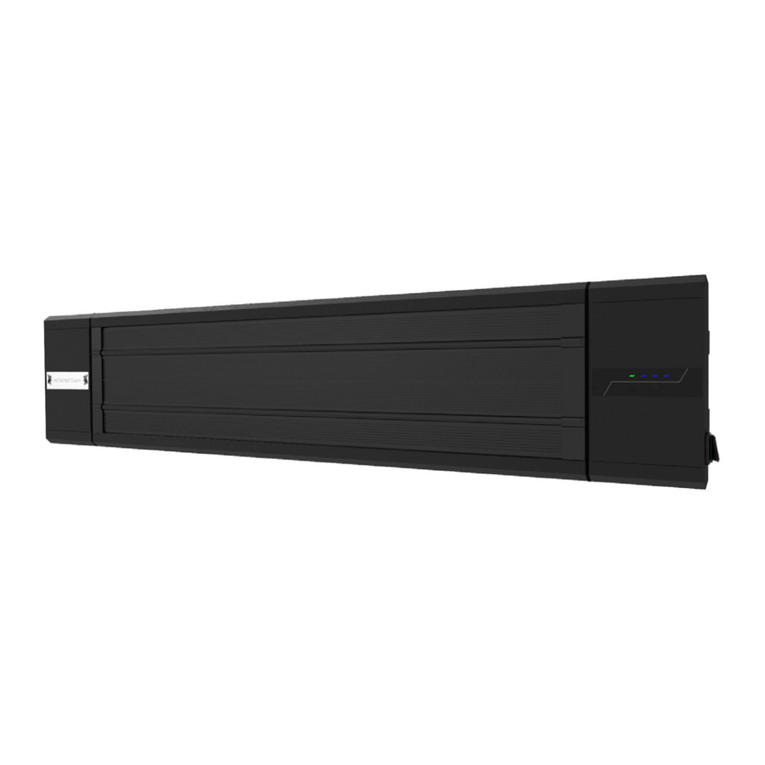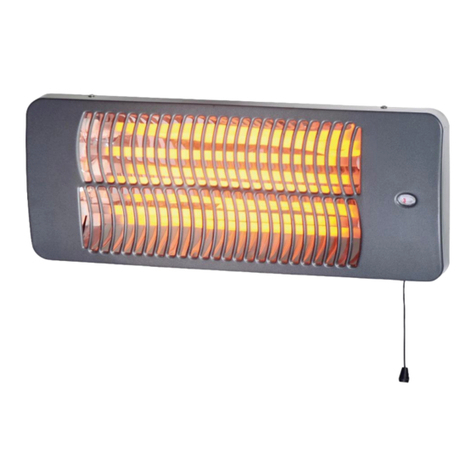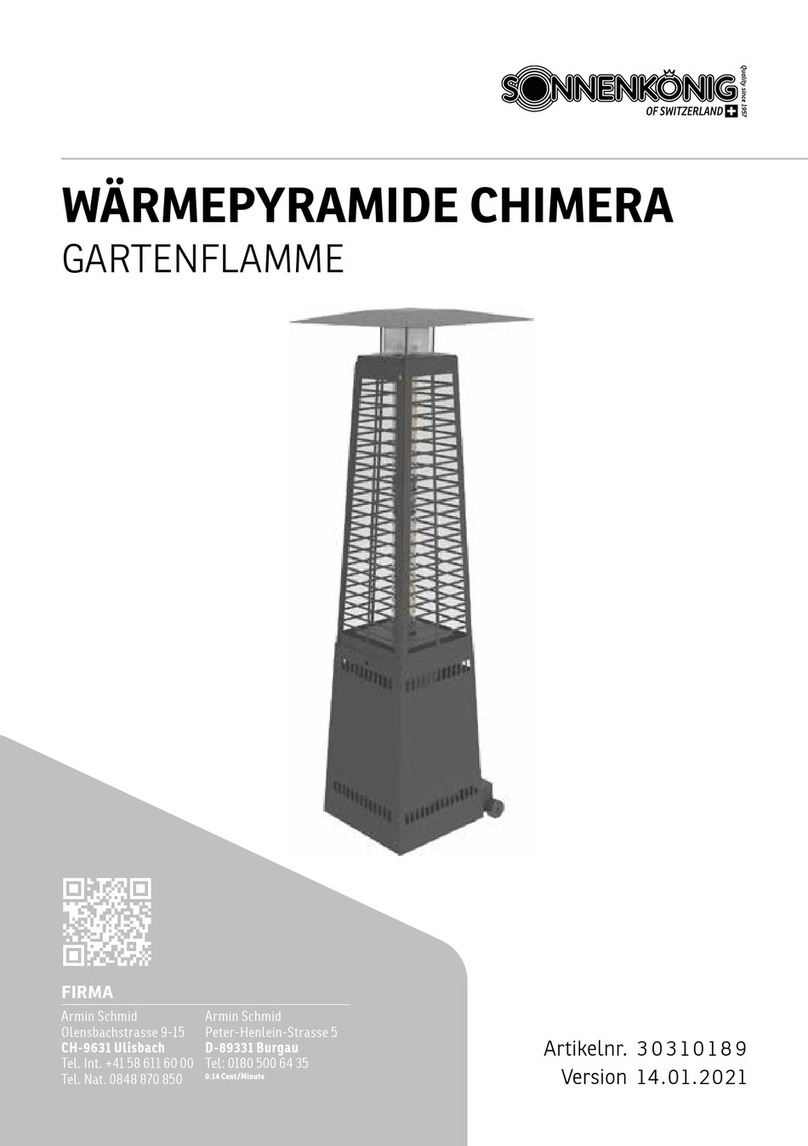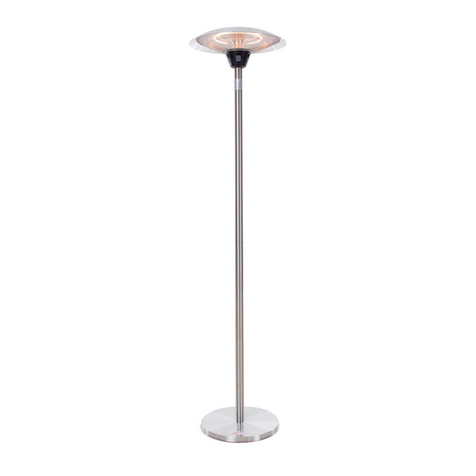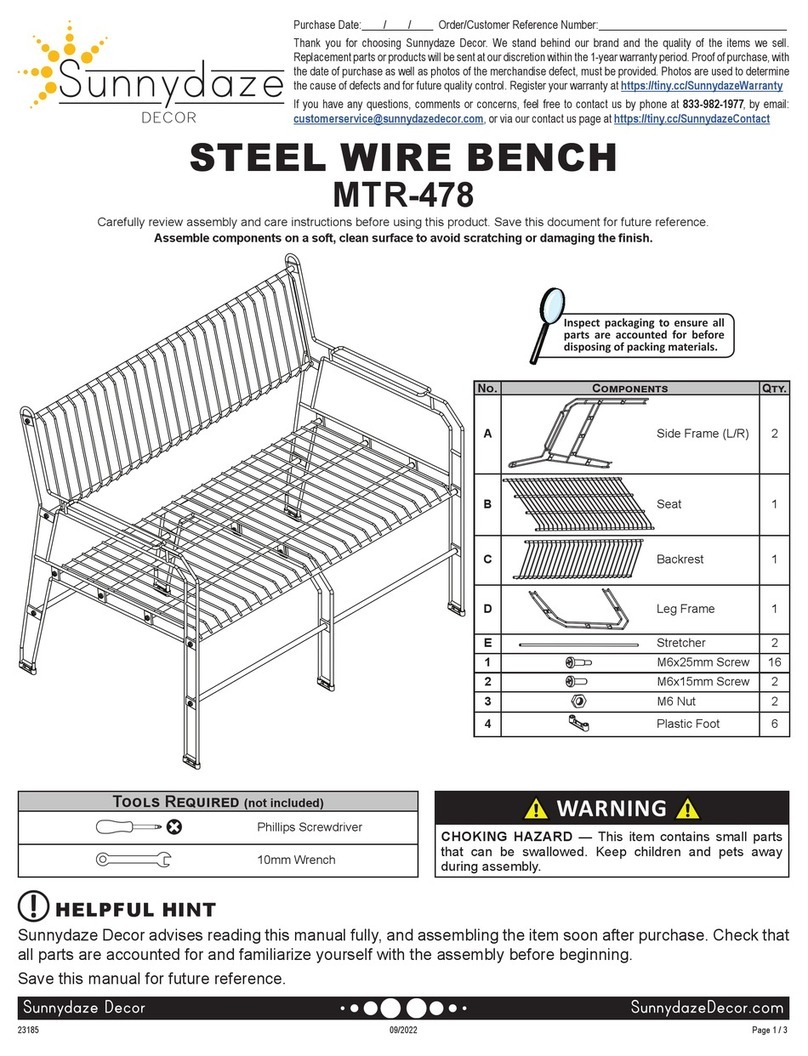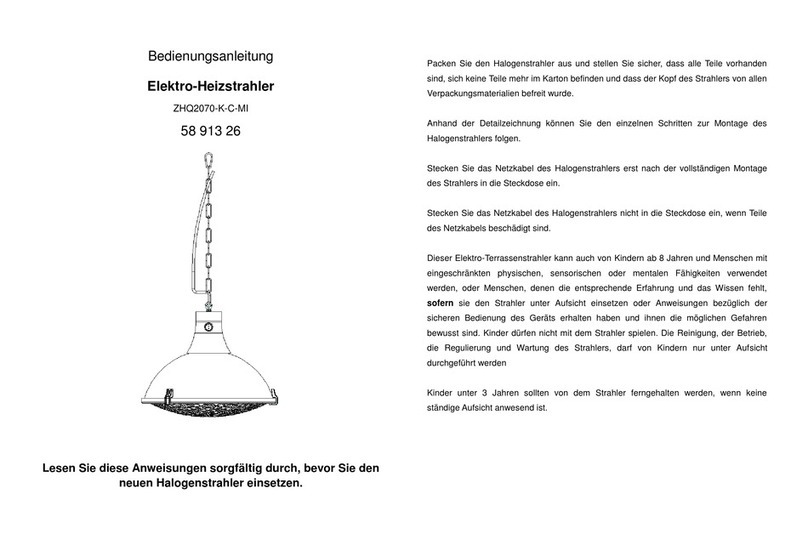Changzhou Gardensun Furnace HSS-A-SS User manual

Owner’s
Manual
MODEL: HSS-A-SS
IMPORTANT
Read this manual carefully before
assembling, using or servicing this
heater. Keep this manual for future
reference.
ANSI Z83.26-2007/CSA 2.37-2007 Gas-Fired Outdoor Infrared Patio Heaters
PATIO HEATER
RR

1
Contents
General Safety Information....................................... 1
snoitcurtsnIylbmessA
Components & Hardware.......................................
.
3
Additional Requirements ........................................ 3
ssecorPnoitallatsnI
Step 1 –Attach Support Brackets to Base..............
.
4
Step 2 – Attach Pole to Support Brackets............... 5
Step 3 – Load Cylinder Housing onto Pole............. 5
Step 4 – Attach Reflector Studs to Screen Cover... 5
Step 5 – Attach Head Assembly to Pole.................
.
5
Step 6 – Install Reflector.........................................
Warranty ................................................................
6
Step 7 – Attach Reflector Assembly to Studs.........
.
7
Step 8 – Connect Hose & Regulator to Cylinder...... 7
Leak Check............................................................. 8
Operation................................................................ 9
01tsilkcehCnoitarepO
Troubleshooting...................................................... 11
12
Maintenance........................................................... 11
Storage...................................................................
.
12
Service.................................................................... 12
General Safety Information
This manual contains important information about the
assembly, operation and maintenance of this patio heater.
General safety information is presented in these first few
pages and is also located throughout the manual.
Keep this manual for future reference and to educate
new users of this product. This manual should be read in
conjunction with the labeling on the product.
Safety precautions are essential when any mechanical
or propane fueled equipment is involved. These
precautions are necessary when using, storing, and
servicing. Using this equipment with the respect and
caution demanded will reduce the possibilities of personal
injury or property damage.
The following symbols shown below are used extensively
throughout this manual. Always heed these precautions,
as they are essential when using any mechanical or
fueled equipment.
DANGER
DANGER indicates an imminently hazardous situation
which, if not avoided, will result in death or serious injury.
WARNING
WARNING indicates an imminently hazardous situation
which, if not avoided, could result in death or serious injury.
DANGER
WARNING
CAUTION
CAUTION indicates an imminently hazardous situation which,
if not avoided, may result in minor or moderate personal injury,
or property damage.
WARNING: For Outdoor Use Only
WARNING
DANGER
Failure to comply with the precautions and instructions
provided with this heater can result in death, serious bodily injury
and property loss or damage from hazards of fire,explosion,
burn, asphyxiation, and/or carbon monoxide poisoning.
Only persons who can understand and follow the instructions
should use or service this heater.
Improper installation, adjustment, alteration, service or maintenance
can cause property damage, injury or death. Read the installation,
operation and maintenance instructions thoroughly before installing
or servicing this equipment.
DANGER CARBON MONOXIDE HAZARD
This appliance can produce carbon
monoxide which has no odor.
Using it in an enclosed space can kill you.
Never use this appliance in an enclosed
space such as a camper, tent or home.
FOR YOUR SAFETY
If you smell gas:
1. Shut off gas to the appliance.
([WLQJXLVKDQ\RSHQÀDPH
3. If odor continues, keep away from the appliance and
immediately call you gas supplier or fire department.
Do not store or use gasoline or other flammable
vapors and liquids in the vicinity of this or any
other appliance.
An LP-cylinder not connected for use shall not be
stored in the vicinity of this or any other appliance.

2
DANGER
• EXPLOSION - FIRE HAZARD
• Keep solid combustibles, such as building materials,
paper or cardboard, a safe distance away from the heater
as recommended by the instructions.
• Provide adequate clearances around air openings into
the combustion chamber.
• Never use the heater in spaces which do or may contain
volatile or airborne combustibles, or products such as
gasoline, solvents, paint thinner, dust particles or unknown
chemicals.
• During operation, this product can be a source of
ignition. Keep heater area clear and free from combustible
materials, gasoline, paint thinner, cleaning solvents and
other flammable vapors and liquids. Do not use heater in
areas with high dust content. Minimum heater clearances
from combustible materials: 36” from the sides & 36” from
the top.
WARNING
We cannot foresee every use which may be made of our
heaters.
Check with your local fire safety authority if you have
questions about heater use.
Other standards govern the use of fuel gases and heat
producing products for specific uses. Your local authorities
can advise you about these.
If no local codes exist, follow National Fuel Gas Code,
ANSI Z223.1. In Canada, installation must conform to local
codes. If no local codes exist, follow the current National
standards of CANADA CAN/CGA-B 149.2.
DANGER
• CARBON MONOXIDE HAZARD
• This heater is a combustion appliance. All combustion
appliances produce carbon monoxide (CO) during the
combustion process. This product is designed to produce
extremely minute, non-hazardous amounts of CO if used
and maintained in accordance with all warnings and
instructions. Do not block air flow into or out of the heater.
• Carbon Monoxide (CO) poisoning produces flu-like
symptoms, watery eyes, headaches, dizziness, fatigue and
possibly death. You can't see it and you can't smell it. It's
an invisible killer. If these symptoms are present during
operation of this product get fresh air immediately!
• For outdoor use only .
• Never use inside house, or other unventilated or
enclosed areas.
• This heater consumes air (oxygen). Do not use in
unventilated or enclosed areas to avoid endangering
your life.
CAUTION
• SERVICE SAFETY
• Keep all connections and fittings clean. Make sure
propane cylinder valve outlet is clean.
• Inspect hose before use. Replace if there is evidence of
abrasion or wear.
• During set up, check all connections and fittings for leaks
using soapy water. Never use a flame.
• Use as a heating appliance only. Never alter in any way or
use with any device.
• Check entire hose at least annually.
WARNING
• BURN HAZARD
• Never leave heater unattended when hot or in use.
• Keep out of reach of children.

3
WARNING
• This product is fueled by propane gas. Propane gas is
invisible, odorless, and flammable. An odorant is normally
added to help detect leaks and can be described as a
“rotten egg” smell. The odorant can fade over time so
leaking gas is not always detectable by smell alone.
• Propane gas is heavier than air and leaking propane will
sink to the lowest level possible. It can ignite by ignition
sources including matches, lighters, sparks or open flames
ofanykindmanyfeetawayfromtheoriginalleak.Useonly
propane gas set up for vapor withdrawal.
• Propane gas should be stored or used in compliance with
local ordinances and codes or with ANSI/NFPA 58. Turn off
propane when not in use.
DANGER
• EXPLOSION - FIRE HAZARD
• Never store propane near high heat, open flames, pilot
lights, direct sunlight, other ignition sources or where
temperatures exceed 120 degrees F (49°C).
• Propane vapors are heavier than air and can accumulate
in low places. If you smell gas, leave the area immediately.
• Never install or remove propane cylinder while heater is
lighted, near flame, pilot lights, other ignition sources or
while heater is hot to touch.
• This heater is red hot during use and can ignite
flammables too close to the burner. Keep flammables at
least 36” from sides & 36” from top. Keep gasoline and
other flammable liquids and vapors well away from heater.
• The propane cylinder must always be stored outdoors in a
well ventilated space. Never store propane cylinder in an
enclosed area (house, garage, etc.). If heater is to be
stored indoors, disconnect the propane cylinder for outdoor
storage.
Assembly Instructions
Components
Remove all components from package.
Reflector Panel(3)
Reflector Plate
Reflector Stud(3)
Heater Burner
Screen
Head Assembly
Cylinder Housing
Regulator
Base
Gas Hose
Reflector Assembly
Ground Fixer
Upper Pole
Lower Pole
Support Bracket(3)

4
Additional Requirements
The following items are not included, but are necessary for
the proper assembly of your heater. Do NOT attempt to
assemble without proper tools.
Philips screwdriver w/ medium blade.
Adjustable opening wrench.
Leak Detection Solution(Instructions on how to make
solution are included in step )
Note: You must follow all steps to properly assemble
heater.
.
WARNING
California Proposition 65
Combustion by products produced when using
this product contain chemicals known to the state
of California to cause cancer, birth defects, and
other reproductive harm.
Step 1 – Attach Support Brackets to Base
.Attach three Support Brackets loosely to Base with
three medium bolts downward through Support
Brackets into the Base.
3 Req’d Medium Bolts
Installation process
Reverse the base, fix the ground
fixer to the base with bolts and
washers like picture shows.
To protect heater from strong wind, anchor
the base securely to the ground
with screws.
Secure the ground fixer with nuts.
Fix another two ground fixer with bolts and nuts,
and reverse the base.
Hardware
Picture Qty Description
Used in
Step(s)
6
13
Large Bolt 2
3Medium Bolt 1
4 Small Bolt
Ground Fixer
9 Small Screw 6
5
9Large Flat
Washer 4 / 7
9Small Flat
Washer 6
2
6Small Flange
Nut 2
9 Cap Nut 6
3WingNut 7
3 Reflector Stud 4
1Wrench
1/2/5/6
6 Small Bolt 1
2 3/16” Screw
6
6
Small Flat
Washer 1
1
Nut
.
For additional assistance or service,
please call: 888-775-1330.
.
.

5
Step 2 – Attach Pole to Support Brackets
Put the upper pole onto the lower pole, using 2pcs
3/16” screws to firmly secure 2pcs pole.The warning
label on the upper pole should be on the same side as
the flat plate of the lower pole.
Install Pole onto three Support Brackets.
Attach Pole to Support Brackets using six large bolts
& six flange nuts.
Fully tighten all of the screws.
Step 3 – Load Cylinder Housing onto Pole
.Load Cylinder Housing onto Pole.
.Slide Cylinder Housing down.
Step 4 – Attach Reflector Studs to Screen Cover
.Insert 3 Reflector Studs & 3 Flat Washers.
.Tighten studs securely.
Step 5 – Attach Head Assembly to Pole
.Screw off 4 small bolts.
3 Req’d Reflector Studs 3 Req’d Large Flat Washers
Head Assembly
4 Req’d Small Bolts
6 Req’d Large Bolts 6 Req’d Small Flange Nut

6
.Load Head Assembly by inserting hose into pole.
.Insert Head Assembly into pole.
.Control knob should be above decal on pole.
.Attach Head Assembly to pole, and loosely install four
small bolts.
.Tighten bolts securely.
Step 6 – Install Reflector
WARNING
Remove protective cover before assemble.
Note: If necessary for proper alignment of reflector
sections, loose each screw prior to further assembly and
retighten after sections are aligned.
.Slide two Reflector
Panels together. .Insert one Small
Screw.
.Slide one Small Flat Washer over threaded end of
screw and screw on Cap Nut loosely.
.Slide Reflector Plate
onto Reflector Panels.
.Insert one Small
Screw.
.Slide one Small Flat
Washer over threaded
end of screw and
screw on Cap Nut
loosely.
.Repeat procedure to complete the assembly of all four
sections.
.Fully tighten all of the screws in the rolled edge.
9 Req’d Small Screw s
9 Req’d Cap Nuts
9 Req’d Small Flat Washers

7
Step 7 – Attach Reflector Assembly to Studs
.Support Heater.
.Slide 3 Large Flat Washers over threaded end of
Studs.
.Locate Reflector Assembly on 3 studs.
.Install large flat washers on studs & securely tighten
wing nuts but do not over-tighten!
Step 8 – Connect Hose & Regulator to Cylinder
The pressure regulator and hose assembly supplied with the
appliance must be used.
The installation must conform with local codes, or in the absence
of local codes,with National Fuel Gas Code, ANSI Z223.1/NFPA54,
Natural Gas and Propane Installation Code, CSA B149.1, or Propane
Storage and Handling Code, B149.2.
A dented, rusted or damaged propane cylinder may be hazardous
and should be checked by your cylinder supplier. Never use a
propane cylinder with a damaged valve connection.
The propane cylinder must be constructed and marked in
accordance with the specifications for LP gas cylinders of the
U.S. Department of Transportation (DOT).
or the Standard for Cylinders, Spheres and Tubes for
Transportation of Dangerous Goods and Commission,
CAN/CSA-B339.
Never connect an unregulated propane cylinder to the heater.
Lift Cylinder Housing.
Screw regulator onto gas hose. Do not cross-thread.
Tighten securely.
Attach regulator to cylinder.
Complete attachment.
Install cylinder.
6 Req’d Large Flat Washers 3 Req’d Wing Nuts
The minimum permissible gas supply pressure of 10 W.C.
is required for purpose of input adjustment.
The minimum hourly of 17000 Btu is required input rating for a
heater for automatic operation at ratings less than full input rating.
You must provide propane gas and propane cylinder .
Use a standard 20 lb. propane
cylinder only.
Use this heater only with a
propane vapor withdrawal
supply system.See
Chapter 5 of the Standard
for Storage and Handling
of Liquefied Petroleum
Gas, ANSI/NFPA 58.Your
local library or fire
department should have
this book.
A minimum supply pressure
of 0.4 p.s.i. is required for
the purpose of input
adjustment for propane
gas.Storage of an appliance indoors is permissible only
if the cylinder is disconnected and removed from the
appliance. A cylinder must be stored outdoors in a
well-ventilated area out of the reach of children. A
disconnected cylinder must have dust caps tightly
installed and must not be stored in a building, garage
or any other enclosed area.
Standard 20 lb. tank
Provided with a cylinder connection device compatible with the
connection for the appliance.
Provided with a listed overfilling prevention device.
The cylinder used must include a collar to protect the cylinder valve.
(a) Do not store a spare LP-gas cylinder under or near this appliance;
(b) Never fill the cylinder beyond 80 percent full;
(c) “Place the dust cap on the cylinder valve outlet whenever the
cylinder is not in use. Only install the type of dust cape on the
cylinder valve that provided with the cylinder valve. Other type of
caps or plugs may result in leakage of propane.”

8
Leak Check
WARNING
• Perform all leak tests outdoors.
• Extinguish all open flames.
• NEVER leak test when smoking.
• Do not use the heater until all connections have been leak
tested and do not leak.
Make 2-3 oz. of leak check solution (one part liquid
dishwashing detergent and three parts water).
Apply several drops of solution where hose attaches
to regulator.
Apply several drops of solution where regulator
connects to Cylinder.
Make sure all Patio Heater & Light valves are OFF.
Turn Cylinder Valve ON.
If bubbles appear at any connection, there is a leak.
Turn Cylinder Valve OFF.
If leak is at Hose/Regulator connection: tighten
connection and perform another leak test. If bubbles
continue appearing should be returned to Hose’s place
of purchase.
If leak is at Regulator/Cylinder Valve connection:
disconnect, reconnect, and perform another leak
check. If you continue to see bubbles after several
attempts, cylinder valve is defective and should be
returned to cylinder’s place of purchase.
If NO bubbles appear at any connection, the
connections are secure.
.Turn Cylinder Valve OFF.
NOTE: Whenever gas connections are loosened or
removed, you must perform a complete leak test.
.Complete installation.
Operation
DANGER
• CARBON MONOXIDE HAZARD
• For outdoor use only. Never use inside house, or other
unventilated or enclosed areas. This heater consumes air
(oxygen). Do not use in unventilated or enclosed areas to
avoid endangering your life.
Caution: Do not attempt to operate until you have read
& understand all General Safety Information in this
manual and all assembly is complete & leak checks
have been performed.
Regulator / Cylinder
Connection
Hose / Regulator
Connection

9
.Your heater was designed and approved for outdoor
use only. Do NOT use it inside a building, garage, or
any other enclosed area.
.Make sure surrounding areas are free of combustible
materials, gasoline, and other flammable vapors or
liquids.
.Ensure that there is no obstruction to air ventilation.
.Be sure all gas connections are tight and there are no
leaks.
.Be sure the cylinder cover is clear of debris.
.Be sure any component removed during assembly or
servicing is replaced and fastened prior to starting.
Before Lighting:
.Heater should be thoroughly inspected before each-
use, and by a qualified service person at least
annually.
.If relighting a hot heater, always wait at least 5
minutes.
.Inspect the hose assembly for evidence of excessive
abrasion, cuts, or wear. Suspected areas should be
leak tested. If the hose leaks, it must be replaced prior
to operation. Only use the replacement hose
assembly specified by manufacturer.
Lighting:
Note: This heater is equipped with a Pilot Light that allows
for safer startups and shutdowns. Pilot must be lit before
Main Burner can be started.
5 Push and release the igniter button until pilot flame is
visible through Viewing Hole.
6Once the pilot is lit, continue to depress the control
Knob for 30 seconds.
7 If the pilot dose not stay lit, repeat steps 4 to 6.
Push in and turn the Control Knob to the “LOW” position,
then release Control Knob. If you want a higher temperature,
push in the Control Knob and turn counterclockwise to the
“HIGH” position.
8
9
If after repeating steps 4 to 6 unit does not light, then
-Push in Control Knob and turn counterclockwise to
“PILOT”.
-As you are depressing the Control Knob, place long
stem lighter into the ignition hole on the Emitter
Screen to light the pilot.
-Repeat step 6.
2 Fully open LP cylinder valve.
1 Turn the Control Knob to the “OFF” position.
3 Open Viewing Hole by sliding cover to either side.
4 Push Control Knob IN and rotate to Pilot position.
Note: For initial start or after any cylinder change, hold
Control Knob IN for 2 minutes to purge air from gas lines
before proceeding.
Note: If pilot fails to remain lit, all valves should be closed
and waiiting period of at least 5 minutes should pass before
attempting to light.
Before Turning Gas Supply ON:
Normal Abnormal

10
If you experience any ignition problem please
consult “Troubleshooting” on page 11.
Caution: Avoid inhaling fumes emitted from the
heater’s first use. Smoke and odor from the burning of
oils used in manufacturing will appear. Both smoke
and odor will dissipate after approximately 30 minutes.
The heater should NOT produce thick black smoke.
Note: The burner may be noisy when initially turned on. To
eliminate excessive noise from the burner, turn the Control
Knob to the Pilot position. Then, turn the knob to the level
of heat desired.
WARNING
FOR YOUR SAFETY
Be careful when attempting to manually ignite this heater.
Holding in the control know for more than 10 seconds
before igniting the gas will cause a ball of flame upon
ignition.
When heater is ON:
Emitter screen will become bright red due to intense heat.
The color is more visible at night.
Burner will display tongues of blue and yellow flame. These
flames should not be yellow or produce thick black smoke,
indicating an obstruction of airflow through the burners. The
flame should be blue with straight yellow tops.
If excessive yellow flame is detected, turn off heater and
consult “Troubleshooting” on page 11.
Re-lighting:
Note: For your safety, Control Knob cannot be turned OFF
without first depressing Control Knob in PILOT position and
then rotating it to OFF.
.Turn Control Knob to OFF.
.Wait at least 5 minutes, to let gas dissipate, before
attempting to relight Pilot.
.Repeat the “Lighting” steps on prior page.
WARNING
FOR YOUR SAFETY
Heater will be hot after use. Handle with extreme care.
Shut Down:
.Turn Control Knob clockwise to Pilot. (Normally,
burner will make a slight popping sound when
extinguished.) Burner will extinguish but Pilot will
remain ON.
.To extinguish Pilot, depress Control Knob and
continue to turn it clockwise to OFF.
.Turn Cylinder Valve clockwise to OFF and disconnect
Regulator when heater is not in use.
Note: After use, some discoloration of the emitter screen is
normal.
Operation Checklist
For a safe and pleasurable heating experience, perform
this check before each use.
Before Operating:
I am familiar with entire owner’s manual and understand all
precautions noted.
All components are properly assembled, intact and operable.
No alterations have been made.
All gas connections are secure and do not leak.
Wind velocity is below 10 mph.
Unit will operate at reduced efficiency below 40°F.
Heater is outdoors (outside any enclosure).
There is adequate fresh air ventilation.
Heater is away from gasoline or other flammable
liquids or vapors.
Heater is away from windows, air intake openings,
sprinklers and other water sources.
Heater is at least 36" on top and at least 36" on sides
from combustible materials.
Heater is on a hard and level surface.
There are no signs of spider or insect nests.
All burner passages are clear.
All air circulation passages are clear.
Children and adults should be alerted to the hazards
of high surface temperatures and should stay away to
avoid burns or clothing ignition.
Young children should be carefully supervised when
they are in the area of the heater.
Clothing or other protective material should not be hung
from the heater, or placed on or near the heater.
Any guard or other protective device removed for servicing
the heater must be replaced prior to operating the heater
Installation and repair should be done by a qualified service
person. The heater should be inspected before use and ate
least annually by a qualified service person.
More frequent cleaning may be required as necessary. It is
imperative that control compartment, burner and circulating
air passageways of the heater be kept clean.
After Operation
Gas control is in OFF position.
Gas Tank valve is OFF.
Disconnect Gas line.

11
Troubleshooting
If the problem is: And this condition exists: Then do this
Pilot won’t light
Cylinder valve is closed Open valve
Blockage in orifice or pilot tube Clean or replace orifice or pilot tube
Air in gas line
Open gas line and bleed it (pressing control
knob in) for not more than 1 - 2 minutes or until
you smell gas
Low gas pressure with cylinder valve
fully open Turn cylinder valve OFF and replace cylinder
Note: Heater operates at
reduced efficiency below 40ºF
(5ºC) Igniter fails Use match to light pilot; obtain new igniter and
replace
Pilot won’t stay lit
Dirt built up around pilot Clean dirt from around pilot
Connection between gas valve and
pilot assembly is loose Tighten connection and perform leak check
Thermocouple is not operating correctly Replace thermocouple
Burner won’t light
Gas pressure is low Turn cylinder valve OFF and replace cylinder
Blockage in orifice Clear blockage
Control knob is not in ON position Turn control knob to ON
Burner flame is low
Gas pressure is low Turn cylinder valve OFF and replace cylinder
Outdoor temperature is less than 40ºF
and tank is less than 1/4 full Use a full cylinder
Supply hose is bent or kinked Straighten hose
Control knob fully ON Check burner and orifices for blockage
Carbon build-up Dirt or film on reflector and burner screen Clean reflector and burner screen
Thick black smoke Blockage in burner Remove blockage and clean burner inside and
outside
Maintenance
WARNING
FOR YOUR SAFETY:
• Do NOT touch or move heater for at least 45 minutes
after use.
• Reflector is hot to the touch.
• Allow reflector to cool before touching.
To enjoy years of outstanding performance from your
heater, make sure you perform the following maintenance
activities on a regular basis:
Air flow must be unobstructed. Keep controls, burner,
and circulating air passageways clean. Signs of possible
blockage include:
a. Keeping the appliance area clear and free from combustible
materials , gasoline and other flammable vapors and liquids.
b. Not obstructing the flow of combustion and ventilation air.
Keep exterior surfaces clean.
Use warm soapy water for cleaning. Never use
flammable or corrosive cleaning agents.
While cleaning your unit, be sure to keep the area around the
burner and pilot assembly dry at all times. Do not submerge the
control valve assembly. If the gas control is submerged in water,
do NOT use it. It must be replaced.
c.Keeping the ventilation opening(s) of the cylinder enclosure
free and clear from debris.

12
.Gas odor with extreme yellow tipping of flame.
.Heater does NOT reach the desired temperature.
.Heater glow is excessively uneven.
.Heater makes popping noises.
.Spiders and insects can nest in burner or orifices.
This dangerous condition can damage heater and
render it unsafe for use. Clean burner holes by using
a heavy-duty pipe cleaner. Compressed air may help
clear away smaller particles.
.Carbon deposits may create a fire hazard. Clean
dome and burner screen with warm soapy water if
any carbon deposits develop.
Note: In a salt-air environment (such as near an ocean),
corrosion occurs more quickly than normal. Frequently
check for corroded areas and repair them promptly.
TIP:
Use high-quality automobile wax to help maintain the
appearance of your heater. Apply to exterior surfaces from
the pole down. Do not apply to emitter screen or domes.
Storage
Between uses:
.Turn Control Knob OFF.
.Disconnect LP source.
.Store heater upright in an area sheltered from direct
contact with inclement weather (such as rain, sleet,
hail, snow, dust and debris).
.If desired, cover heater to protect exterior surfaces
and to help prevent build up in air passages.
Note: Wait until heater is cool before covering.
During periods of extended inactivity or when
transporting:
.Turn Control Knob OFF.
.Disconnect LP source and move to a secure,
well-ventilated location outdoors.
.Store heater upright in an area sheltered from direct
contact with inclement weather (such as rain, sleet,
hail, snow, dust and debris).
.If desired, cover heater to protect exterior surfaces
andtohelppreventbuildupinairpassages.
.Never leave LP cylinder exposed to direct sunlight or
excessive heat.
Note: Wait until heater is cool before covering.
Service
Warranty
Repair to gas passages and associated components
should be done only by a qualified service person.
Caution: Always allow heater to cool before
attempting service.
Heater’s warranty extends for 1 years from date of
purchase by original purchaser.
Manufactured by:
Changzhou Gardensun Furnace Co., Ltd. No. 1, Boyi Town,
Changzhou City, Jiangsu Province P.R. China.
Manufacturer will cover:
All parts found to be defective due to materials or
workmanship for 1 years from the date of original
purchase. Proof of purchase is required before warranty
performance will be rendered. Sales receipt and
validation of product registration are valid forms of proof
of purchase.
Warranty Exclusion
Manufacturer will NOT cover:
Assembly or start-up
Normal adjustment to burner
Cleaning and/or general maintenance
Legal Rights
No one else is authorized to make any warranties on behalf
of manufacturer.
THIS WARRANTY IS IN LIEU OF ANY OTHER WARRANTY,
EXPRESS OR IMPLIED, ORAL OR WRITTEN,
INCLUDING, BUT NOT LIMITED TO, ANY WARRANTY OF
MERCHANTABILITY OR FITNESS FOR A PARTICULAR
PURPOSE.
Manufactured by:
Changzhou Gardensun Furnace Co., Ltd.
No. 1, Boyi Town, Changzhou City,
Jiangsu Province P.R. China
Tel: 86-519-83317471
Fax: 86-519-83315116
Http: www.jiadeshun.com
For additional assistance or service, please call: 888-775-1330.

Manual
del Usuario
MODELO: HSS-A-SS
IMPORTANTE
Lea este manual minuciosamente
antes de ensamblar, encender o
dar servicio al calentador.
Conserve este manual para
referencias futuras.
CALENTADOR DE PATIO
RR
ANSI Z83.26-2007/CSA 2.37-2007 de Gas Externo infrarrojo Calefactor para el patio

1
Contenidos
Información General de Seguridad .............................. 1
Instrucciones de Montaje
Componentes & Hardware ......................................... 3
Requisitos Adicionales ............................................. 3
Proceso de Instalación
Paso 1 –Fijar Soportes a la base ............................... 4
Paso 2 –Fijar Poste a los Soportes ........................... 5
Paso 3 –Cargar Carcasa de Cilindro sobre Poste ........ 5
Paso 4 –Fijar Pernos del Reflector a la Tapa Pantalla ... 5
Paso 5 –Fijar Conjunto de cabezas al Poste.................
.
5
Paso 6 – Instalar Reflector ......................................... 6
Paso 7 –Fijar Conjunto de Reflector a los Pernos .........
.
7
Paso 8 –Conectar Manguera & Regulador al Cilindro ... 7
Chequeo de Fuga ..................................................... 8
Operación ................................................................ 9
Lista de comprobación de operación 10
Resolución de problemas .............................................
Garantía ...........................................................................
11
Mantenimiento........................................................... 11
Almacenamiento ....................................................... 12
Servicio .................................................................... 12
12
Información General de Seguridad
Este manual contiene la información importante sobre el
ensamblaje, la operación y mantenimiento del calentador
de patio. La información general de seguridad que aparece
en estas primeras paginas se encuentra a lo largo del
manual.
Conserve este manual para referencias futuras en caso
de que los que vayan a usar el aparato puedan tener la
información que necesiten.
Las precauciones de seguridad son esenciales en cuanto
un equipo mecánico o de abastecimiento de propano está
implicado. Estas precauciones son necesarias al usar,
almacenar y dar servicio al calentador. Manipular este
equipo con las cautelas requiridas reduce las posibilidades
de perjudiciar a las personas o daños a la propiedad.
Los símbolos siguientes demostrados abajo se utilizan
extensamente durante todo el manual. Preste atención
siempre a estas precauciones, pues son esenciales al usar
cualquier equipo mecánico o equipo de abastecimiento.
PELIGRO
PELIGRO indica una situación de peligro inminente la cuál,
al no evitar, podría causar la muerte o lesiones graves.
ADVERTENCIA
ADVERTENCIA indica una situación peligrosa inminentemente la
cuál, si no evitada, podría dar lugar a muerte o a lesión seria.
PELIGRO
ADVERTENCIA
PRECAUCIÓN
PRECAUCIÓN indica una situación peligrosainminentemente la
cuál, si no evitada, puede dar lugar a daños materiales o daños
corporales menor o moderado.
ADVERTENCIA: Para el uso al aire libre
solamente.
ADVERTENCIA
PELIGRO
El inclumplimiento de las precauciones y las instrucciones
proveidas con este calentador dará lugar a muerte, lesión
corporal seria y daños materiales o daños de riesgo de
incendios, explosión, quemadura, asfixia, y/o intoxicación
de monóxido de carbono.
Sólo las personas quiénes pueden entender y seguir las
instrucciones deben utilizar o mantener este calentador.
La instalación, ajuste, modificación,
mantenimiento o servicio puede causar daño, lesión o muerte,
Lea la instrucción de instalación, operación y mantenimiento
enteramente antes de instalar o dar servicio a este aparato.
PELIGRO Intoxicación DEL MONÓXIDO DE
CARBONO
Este equipo puede producer el monóxido
de carbono que no tiene nigun olor.
Nunca utilizen este equipo en espacios
cerrados, tales como campista, tienda y
casa, puede causar intoxicación.
PARA SU SEGURIDAD
Si usted huele el gas:
1. Corte gas al aparato.
2. Extinga la llama abierta.
3. Si el olor continúa, llame inmediatamente a
su proveedor de gas o cuerpo de bomberos.
No almacene ni utilice la gasolina u otra vapor
y líquidos inflamables alrededor de esto o
cualquier otro aparato.
En el momento de que el LP-cilindro no esté connectado con el
aparato, no se debe almacenar cerca de el aparato o los otros.

2
PELIGRO
• EXPLOSIÓN - RIESGO DE INCENDIOS • PELIGRO DE MONÓXIDO DE CARBONO
• Mantenga los combustibles sólidos, tales como
materiales de construcción, papel o cartulina, una
distancia de seguridad alejado del calentador según
lo recomendado por las instrucciones.
• Nunca utilice el calentador en los espacios que pueden
contener combustibles volátiles o aerotransportados, o
los productos tales como gasolina, solventes, disolvente
para pinturas, partículas de polvo o productos químicos
desconocidos.
•Nunca utilice el calentador en los espacios que pueden
contener combustibles volátiles o aerotransportados, o
los productos tales como gasolina, solventes, disolvente
para pinturas, partículas de polvo o productos químicos
desconocidos.
• Durante la operación, este producto puede ser una
fuente de ignición. Mantenga el área de calentador
limpio y libre de los materiales combustibles, gasolina,
disolvente para pinturas, disolventes limpiadores y otros
vapores y líquidos inflamables. No utilice el calentador
en áreas con el alto contenido de polvo. Especios
mínimos del calentador de los materiales combustibles:
36” de los lados & 36” de la tapa.
ADVERTENCIA
No podemos prever cada uso que se pueda hacer de
nuestros calentadores.
Compruebe con su autoridad de seguridad de fuego local
si usted tiene preguntas sobre uso del calentador.
Otros estándares gobiernan el uso de gases y calor de
combustible produciendo los productos para los usos
específicos. Su autoridades locales pueden aconsejarte
sobre éstos.
Si no existen códigos locales, siga el código nacional de
gas de combustible, ANSI Z223.1. En Canadá, la
instalación debe conformarse con los códigos locales. Si
no existen códigos locales, siga los estándares
nacionales actuales de CANADÁ CAN/CGA-B 149.2
PELIGRO
• Este calentador es un aparato de combustión. Todos los
aparatos de combustión producen el monóxido de
carbono (CO) durante proceso de combustión. Este
producto se diseña para producir gran cantidad de CO
extremadamente minucioso y no-peligroso si está
utilizado y mantenido de acuerdo con todas las
advertencias y instrucciones. No bloquear el flujo del aire
adentro o afuera del calentador.
• La intoxicación de Monóxido de Carbono (CO) produce
síntomas gripales, ojos llorosos, dolores de cabeza,
vértigo, fatiga y posiblemente muerte. Usted no puede
verlo ni puede olerlo. Es un asesino invisible. ¡Si estos
síntomas están presentes durante la operación de este
producto consiga el aire fresco inmediatamente!
• Para el uso al aire libre solamente.
• Nunca utilice en la casa, u otras áreas cerradas sin
ventilación.
• Este calentador consume aire (oxígeno). No utilice en
áreas cerradas sin ventilación para evitar de poner su
vida en peligro.
PRECAUCIÓN
• SEGURIDAD DE SERVICIO
• Mantenga limpias todas las conexiones y uniones.
Cerciórarse de que enchufe de válvula de cilindro de
propano esté limpio.
• Examine la manguera antes de usar. Substituya si hay
evidencia de abrasión o desgaste.
• Durante la instalación, compruebe todas las conexiones
y uniones para ver si tiene fugas usando el agua jabonosa.
Nunca utilice una llama.
• Use como aparato de calefacción solamente. Nunca altere
de cualquier manera o utilice con cualquier dispositivo.
• Compruebe la manguera entera anualmente por lo menos.
ADVERTENCIA
• PELIGRO DE QUEMADURA
• Nunca deje el calentador desatendido cuando es caliente
o en uso.
• Mantenga el calentador fuera del alcance de los niños.

3
ADVERTENCIA
• Este producto es aprovisionado de combustible por gas
de propano. Gas de propano es invisible, inodoro, e
inflamable. Un odorante se agrega normalmente a la ayuda
en la detección de escapes y se puede describir como olor
de “huevo podrido”. El odorante puede descolorar en un
cierto plazo así que el gas escapado no es siempre
perceptible por el olor solo
• Gas de propano es más pesado que aire y propano
escapado se hundirán al nivel más bajo posible. Puede
encender por fuentes de ignición incluyendo fósforos,
mecheros, chispas o llamas abiertas de cualquier tipo a
unos pies lejos del escape original. Utilice solamente gas
de propano instalado para retirada de vapor.
• Gas de propano debe ser almacenado o utilizado de
acuerdo con ordenanzas y códigos locales o con
ANSI/NFPA 58. Corte propano cuando no en uso.
PELIGRO
• EXPLOSIÓN - RIESGO DE INCENDIOS
• Nunca almacene el propano cerca de alta temperatura,
llamas abiertas, luces testigos, luz de sol directa, otras
fuentes de ignición o donde las temperaturas exceden 120
grados F (49°C).
• Los vapores de propano son más pesados que aire y
pueden acumular en lugares bajos. Si hueles el gas,
salga del área inmediatamente.
• Nunca instale o quite el cilindro de propano mientras se
enciende calentador, cerca de llama, luz testigo, otras
fuentes de ignición o mientras que el calentador es
demasiado para tocar.
• Este calentador es candente durante uso y puede
encender tan cerca del quemador. Mantenga los inflamables
por lo menos 36” de lados & 36” de la tapa. Mantenga
la gasolina y otros líquidos inflamables y vapores alejado del
calentador.
• El cilindro de propano se debe almacenar siempre al aire
libre en un espacio bien ventilado. Nunca almacene el
cilindro de propano en un área cerrado (casa, garage, etc.).
Si se va a almacenar interior el calentador, desconecte el
cilindro de propano para el almacenaje al aire libre.
Instrucciones de Montaje
Componentes
Sacar todos los componentes del paquete.
Panel de Reflector (3)
Reflector Chapa
Perno de Reflector (3)
Quemador de
calentador
Pantalla
Conjunto de cabezas
Carcasa de Cilindro
Regulador
Base
Manguera de Gas
Conjunto de Reflector
Fijador de Tierra
Poste superior sobre
Poste más bajo
Soporte(3)

4
Hardware
Imagen Cant. Descripción
Utilizado en
Paso(s)
6Perno grande 2
3Perno medio 1
9 Tornillo Pequeño 6
9Arandela Grande
Arandela 4 / 7
9Plana Pequeña
Arandela 6
6Tuerca de brida
Pequeña 2
9 Tuerca ciega 6
3 Tuerca de mariposa 7
3 Perno de Reflector 4
1Llave
1/2/5/6
Requisitos Adicionales
Los siguientes elementos no están incluidos, pero son
necesarios para el correcto ensamblaje de su calentador.
No intente el ensamblaje del equipo sin las herramientas
adecuadas.
Destornillador Phillips con lámina media.
llave de boca ajustable.
Solución de detección de fugas (Instrucciones sobre
cómo realizar la solución son incluidass en paso).
Nota: Deba seguir todos los pasos para ensamblar el
calentador de un modo adecuado.
Proceso de Instalación
.
.
.
Paso 1–Fijar Soportes a la base
.Fijar sin apretar tres Soportes a la Base con
tres pernos medios hacia abajo por Soportes
en la Base.
3 Pernos Medios de Req’d
ADVERTENCIA
Propuesta de California 65
Los subproductos de combustión producidos al
utilizar este producto contiene los productos
químicos conocidos al estado de California para
causar cáncer, defectos de nacimiento, y otro
daño reproductivo.
Invierta la base, fije el fijador de
tierra a la base mediante pernos
y arandelas como se indica en
el cuadro.
Para proteger el calentador del viento fuerte, ancle
con seguridad la base a la tierra
mediante los tornillos.
Fije el fijador de tierra mediante
tuercas.
Fije otros dos fijadores de tierra mediante pernos y
tuercas, y invierta la base.
13 Fijador de Tierra
6 Perno Pequeñ o 1
4 Perno Pequeñ o 5
2
6
6
Plana Pequeña
Arandela 1
1
Tuerca
Para obterner ayuda adicional o servicio,
por favor llame al: 888-775-1330
2 3/16” Tornillo

5
Paso 2 –Fijar Poste a los Soportes
Instalar el poste sobre tres soportes.
Fijar Poste a los Soportes mediante seis pernos
grandes & seis tuercas de pestaña.
Apretar todos los tornillos hasta el fondo.
Paso 3 –Cargar Carcasa de Cilindro
.Cargar Carcasa de Cilindro.
.Deslizar Carcasa de Cilindro hacia abajo.
Paso 4 –Fijar Pernos del Reflector
.Insertar 3 pernos de reflector & 3 Arandelas planas.
.Apretar con seguridad los pernos.
Paso 5 – Fijar Conjunto de cabezas al Poste
.Desenroscar 4 pernos pequeños.
6 Pernos grandes Req’d
6 tuercas de pestaña pequeñas Req’d
3 pernos de reflector Req’d 3 Arandelas Planas
Grandes Req’d
Reunión de cabezas
4 pernos pequeños Req’d
Ponga el poste superior sobre el poste inferior, usando
dos tornillos de 3/16” para conjuntar los dos postes. La
etiqueta de advertencia en la parte superior del poste
debe estar en el mismo lado del plato llano de polo
inferior.

6
.Cargar Conjunto de Cabezas por insertar en el poste.
.Insertar Conjunto de Cabezas en el poste.
.Botón de control debe estar sobre etiqueta en poste.
.Fijar Conjunto de Cabezas al poste, y instalar cuatro
pernos pequeños sin apretar.
.Apretar con seguridad
pernos.
Paso 6 – Instalar Reflector
WARNING
Suprima cubierta protectora antes reúnase.
Nota: Si es necesario para la alineación adecuada de
secciones de reflector, suelte cada tornillo antes del
montaje adicional y volverlo a apretar luego de alinear
las secciones.
.Deslizar dos Reflectore
s
junto. .Insertar uno panel
pequeño tornillo..
.Deslizar una Arandela Plana pequeña sobre la cabeza
ensanchada de tornillo y tornillo en Tuerca de
Cabeza sin a
p
retar.
.Deslizar Reflector
Chapa sobre Panel de
Reflector
.Insertar un tornillo
pequeño.
.Deslizar una arandela
plana pequeña sobre
la cabeza ensanchada
de tornillo y tornillo en
Tuerca de Cabeza sin
apretar.
.Repetir el procedimiento para acabar el montaje de
las cuatro secciones.
.Apretar todos los tornillos en el border hasta el fondo.
9 Req’d Tornillo Pequeñ o
9 Tuercas de Cabeza Req’d
9 Req’d Arandelas planas peq
Other manuals for HSS-A-SS
1
Table of contents
Languages:
Other Changzhou Gardensun Furnace Patio Heater manuals

Changzhou Gardensun Furnace
Changzhou Gardensun Furnace HLS01-CGT User manual

Changzhou Gardensun Furnace
Changzhou Gardensun Furnace HSS-A User manual

Changzhou Gardensun Furnace
Changzhou Gardensun Furnace HSS User manual
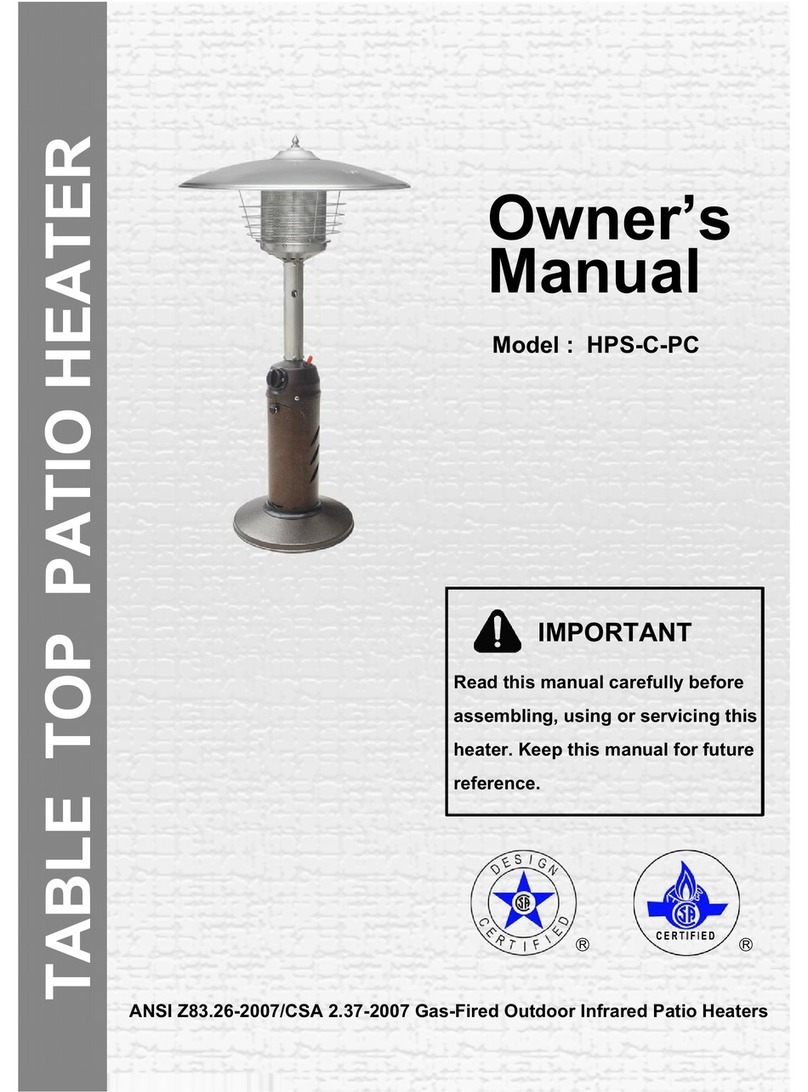
Changzhou Gardensun Furnace
Changzhou Gardensun Furnace HPS-C-PC User manual

Changzhou Gardensun Furnace
Changzhou Gardensun Furnace HSS-A-GH User manual

Changzhou Gardensun Furnace
Changzhou Gardensun Furnace HSS-A-SS User manual

Changzhou Gardensun Furnace
Changzhou Gardensun Furnace HSS-NG-SS User manual

Changzhou Gardensun Furnace
Changzhou Gardensun Furnace NCZH-G-SS User manual
